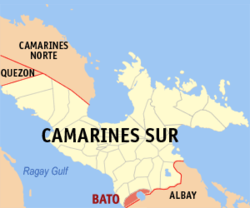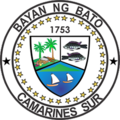Bato, Camarines Sur
Municipality in Camarines Sur, Philippines From Wikipedia, the free encyclopedia
Bato, officially the Municipality of Bato (Rinconada Bikol: Banwāan ka Bato; Tagalog: Bayan ng Bato), is a municipality in the province of Camarines Sur, Philippines. According to the 2020 census, it has a population of 52,155 people.[3]
This article needs additional citations for verification. (January 2013) |
Bato | |
|---|---|
| Municipality of Bato | |
 Municipal Hall | |
| Anthem: Bato, Banwaan na Ginikanan | |
 Map of Camarines Sur with Bato highlighted | |
Location within the Philippines | |
| Coordinates: 13°21′28″N 123°22′04″E | |
| Country | Philippines |
| Region | Bicol Region |
| Province | Camarines Sur |
| District | 5th district |
| Barangays | 33 (see Barangays) |
| Government | |
| • Type | Sangguniang Bayan |
| • Mayor | Domingo L. Zorilla Jr |
| • Vice Mayor | Victorio S. Ramos |
| • Representative | Miguel Luis R. Villafuerte |
| • Municipal Council | Members |
| • Electorate | 33,077 voters (2022) |
| Area | |
• Total | 107.12 km2 (41.36 sq mi) |
| Elevation | 13 m (43 ft) |
| Highest elevation | 59 m (194 ft) |
| Lowest elevation | 4 m (13 ft) |
| Population (2020 census)[3] | |
• Total | 52,155 |
| • Density | 490/km2 (1,300/sq mi) |
| • Households | 10,782 |
| Economy | |
| • Income class | 3rd municipal income class |
| • Poverty incidence | 37.28 |
| • Revenue | ₱ 228.3 million (2022) |
| • Assets | ₱ 621.3 million (2022) |
| • Expenditure | ₱ 189.9 million (2022) |
| • Liabilities | ₱ 365.6 million (2022) |
| Service provider | |
| • Electricity | Camarines Sur 3 Electric Cooperative (CASURECO 3) |
| Time zone | UTC+8 (PST) |
| ZIP code | 4435 |
| PSGC | |
| IDD : area code | +63 (0)54 |
| Native languages | Rinconada Bikol Central Bikol Tagalog |
The municipality of Bato is home to a lake teeming with various kinds of fishes. Sinarapan, the world's smallest commercially harvested fish, occupies the waters of Lake Bato. Also present, the lake abounds with tilapia housed in fish cages.
Bato is 26 kilometres (16 mi) from Pili and 476 kilometres (296 mi) from Manila.
History
This town was formerly called as "Kaliligno" or "Caliligno" named by the natives that settled along the river area.
This small village later was elevated into a status of a town under the decree of Spanish Superior Government on February 15, 1753. Years back, a parish was already existing which was also made under the same decree. This parish adopted "The Most Holy Trinity" as its patron saint. Its feast day is celebrated every Sunday after the Pentecost. The Bato is also known for its best noodles called Pansit Bato.
Geography
Summarize
Perspective
Barangays
Bato is politically subdivided into 33 barangays. Each barangay consists of puroks and some have sitios.
- Agos
- Bacolod
- Buluang
- Caricot
- Cawacagan
- Cotmon
- Cristo Rey
- Del Rosario
- Divina Pastora (Poblacion)
- Goyudan
- Lobong
- Lubigan
- Mainit
- Manga (Mangga)
- Masoli
- Neighborhood
- Niño Jesus
- Pagatpatan
- Palo
- Payak
- Sagrada (Sagrada Familia)
- Salvacion
- San Isidro
- San Juan
- San Miguel
- San Rafael (Poblacion)
- San Roque
- San Vicente
- Santa Cruz (Poblacion)
- Santiago (Poblacion)
- Sooc
- Tagpolo
- Tres Reyes (Poblacion)
Climate
| Climate data for Bato, Camarines Sur | |||||||||||||
|---|---|---|---|---|---|---|---|---|---|---|---|---|---|
| Month | Jan | Feb | Mar | Apr | May | Jun | Jul | Aug | Sep | Oct | Nov | Dec | Year |
| Mean daily maximum °C (°F) | 33 (91) |
32 (90) |
35 (95) |
37 (99) |
37 (99) |
36 (97) |
35 (95) |
33 (91) |
35 (95) |
34 (93) |
33 (91) |
32 (90) |
34 (94) |
| Mean daily minimum °C (°F) | 26 (79) |
26 (79) |
28 (82) |
30 (86) |
31 (88) |
31 (88) |
29 (84) |
28 (82) |
29 (84) |
28 (82) |
28 (82) |
27 (81) |
28 (83) |
| Average precipitation mm (inches) | 51.03 (2.01) |
78.13 (3.08) |
55.3 (2.18) |
83.07 (3.27) |
159.34 (6.27) |
239.88 (9.44) |
385.8 (15.19) |
391.75 (15.42) |
293.65 (11.56) |
401.33 (15.80) |
108.2 (4.26) |
334.9 (13.19) |
2,582.38 (101.67) |
| Average rainy days | 21 | 24 | 19 | 20 | 25 | 29 | 31 | 29 | 29 | 29 | 27 | 30 | 313 |
| Source: World Weather Online[5] | |||||||||||||
Demographics
Summarize
Perspective
|
|
| ||||||||||||||||||||||||||||||||||||||||||||||||||||||
| Source: Philippine Statistics Authority[6][7][8][9] | ||||||||||||||||||||||||||||||||||||||||||||||||||||||||
In the 2020 census, the population of Bato, Camarines Sur, was 52,155 people,[3] with a density of 490 inhabitants per square kilometre or 1,300 inhabitants per square mile.
Only about 58.27% of the household population is considered as literate.
Mother tongue of the majority is Riŋkonāda also known as Bikol Rinconada, one of the languages of Bicol region. The population speaks a different form of Rinconada Bikol called Bato variant, a lowland dialect (sinaranəw). Natives are also conversant with Coastal Bikol, Filipino/Tagalog and English languages.
Religion

- Roman Catholicism is the predominant religion, followed by the Iglesia ni Cristo as the largest minority.
- Other religious denominations include Church of Jesus Christ of Latter Day Saints; United Churches of Christ in the Philippines Seventh Day Adventist; Bible Baptist; Born Again; Jehovah's Witnesses; Protestants; Aglipay and Islam.
- There are three (3) Catholic Churches in Bato.
Economy
Poverty incidence of Bato
10
20
30
40
50
60
2000
50.75 2003
43.73 2006
38.90 2009
40.09 2012
40.30 2015
41.22 2018
30.85 2021
37.28 Source: Philippine Statistics Authority[10][11][12][13][14][15][16][17] |
Majority of employment is within agriculture, fishery, poultry and construction industry groups.[18]
- Commerce and industry
- 96 commercial establishments engaged in retail trade
- 46 commercial establishments engaged in services
- 1 commercial establishment engaged in real estate - MTBK Co.
- 1 engaged in banking and finance
- 31 industrial establishments
- 2 Hotels - Casa de Piedra and MTBK Hotel
Natural resources include clams, pearls, local shrimps, tabios, and tilapia, particularly within Lake Bato; forest products such as anahaw leaves and local bamboo; non-metallic mineral resources such as white clay among others.
- Agriculture Sector
- 78.087 square kilometers of Agricultural Lands devoted to crop production
- Rice, corn, coconut, root crops, vegetables, and fruit-bearing trees.
- Numerous farm and poultry products found
Local government
Summarize
Perspective
The list of the incumbent and former officials of the Municipality of Bato is the following:[19]
2022–present:
- Mayor: Domingo L. Zorilla Jr
- Vice-Mayor: Victorio S. Ramos
- Councilors:
- Josebello Buquid
- Martin G. Batacan
- Noel C. Tino
- Alvin O. Sacueza
- Adolfo A. Ramos Jr.
- Noel C. Tuyay
- Erwin Nestor O. Rempola Jr.
2019-2022:[20]
- Mayor: Hon. Francisco B. Bernaldez
- Vice-Mayor: Hon. Domingo L. Zorilla Jr.
- Councilors:
- Diosdado T. Zorilla
- Dominici G. Batacan
- Elizabeth Doctolero
- Ignacio L. Hugo
- Jose Samar
- Ban-Ban Aguila
- Matilde Sandrino
- Noel C. Tino
2016-2019:[21]
- Mayor: Hon. Francisco B. Bernaldez
- Vice-Mayor: Hon. Victorio S. Ramos
- Councilors:
- Diosdado T. Zorila
- Domingo L. Zorilla Jr.
- Martin G. Batacan
- Darwin Doctolero
- Edgar R. Argarin
- Nestor A. Orasa
- Danilo S. Mata
- Ignacio L.Hugo
List of former Municipal Mayors
- Paulino Calleja - 1860
- Timoteo Isaac - 1885-1886
- Tomas Barrameda - 1895-1898
- Moises Sayson - 1902-1903
- Agripino Varde - 1908-1912
- Ramon Ripaso - 1913-1916
- Cecilio Coralde - 1917-1919
- Vidal Elpedes - 1920-1922
- Eusebio P. Buena - 1923-1925
- Felix Grageda - 1926 -1928
- Mariano Sesno - 1929-1931
- Juan Belleza - 1932-1934-1938-1940
- Eulogio Buquid - 1935-1937-1941-1942
- Pio B. Mota - 1941-1943-1945-1956-1959
- Domingo Fortuno Jr. - 1944
- Mateo T. Ramos - 1948-1951
- Abundio Intia - 1952-1955
- Jorge R. Tuyay - 1960-1967
- Ernesto S. Tino - 1968-1971
- Nahil Y. Buquid - 1972-1986
- Narciso R. Doctolero Jr. - 1986-1992
- Tito R. Pili - 1992-1998
- Jaime T. Gonzales - 1998-2007
- Jeanette O.R Bernaldez - 2007-2016
- Frank B. Bernaldez - 2016-2022
- Domingo L. Zorilla, Jr. - 2022 - Present
Tourism

- Cotmon Falls
- Arbin Beach Resort
- Lake Bato
- Most Holy Trinity Parish Church
- Maruma Beach
Infrastructure
Summarize
Perspective
Health
- Municipal Health Center and Barangay Health Stations total bed capacity: Eight (8) beds
- Health personnel numbers only about seventeen (17)
Security

Facilities for police protection include Police Station Headquarters near the Municipal Hall in the Poblacion, Police Substation in Barangay Tres Reyes, Police Outpost in Barangay San Miguel. The bureau of Fire Protection of Bato has about eleven (11) firemen personnel.
Transportation
- 19.550 kilometres (12.148 mi) of National Roads
- 45.650 kilometres (28.366 mi) of Provincial Road
- 7.206 kilometres (4.478 mi) of municipal roads
- 38.683 kilometres (24.037 mi) of Barangays Roads
- six (6) bridges
- 235 privately owned vehicles
- public utility vehicles and government vehicles
Utilities
Water supply is provided on 3 levels:
- Level I: wells, springs, or water peddlers common in rural barangays and households
- Level II: communal faucet system
- Level III: Bato Water District provides Level III Water Supply Service generally within the poblacion only
Power and electricity:
- Camarines Sur Electric Cooperative (CASURECO) which provides retails electrical supply to the municipality and maintains a substation
- Domestic Consumptions
- 95.18% with total average consumption rate of 35,595.40 KWH/month Industrial and Commercial Consumption have only about 0.48% connections
- Public buildings, streetlights and other account for the remaining 1.72% number of consumption
Communication facilities include telephone/cellular services, postal services, telegraph services, cable television services, and print and broadcast media services.
Education

Private school institutions:
- Holy Trinity College of Cam. Sur
- Mataas na Paaralan ng Pagatpatan
- Saint John the Baptist Institute of Bicol Inc.
- Ocampo Academy Technological Institute.
- Taburnal Learning Center inc.
- Modern Learning Center
- Verbum Dei School
15 public elementary schools:
- Bato North Central School
- Bato South Central School
- San Vicente Elementary School
- San Miguel Elementary School
- Agos Elementary School
- Nino Jesus Elementary School
- Masoli Elementary School
- San Roque Elementary School
- Atipolo Elementary School
- Carlos Nardo Elementary School
- Manga Elementary School
- Palo Elementary School
- Buluang Elementary School
- Salvacion Elementary School
- Cristo Rey Elementary School
- Sagrada Elementary School
- Dr. Heracleo Guballo Elementary School
- Tagpolo Elementary School
5 public secondary schools:
- Bato National Highschool
- Masoli Highscool
- Salvacion National Highschool
- San Roque National Highschool
- Payak Highschool
1 public library:
- MTBK Divina Pastora Library
Notable personalities
- Maria Venus Raj - Binibining Pilipinas-Universe 2010 and placed 4th Runner-Up in Miss Universe 2010 pageant
References
External links
Wikiwand - on
Seamless Wikipedia browsing. On steroids.




